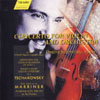Tchaikovsky Violin Concerto; Meditation; Romeo & Juliet
This unique coupling is recommendation enough to buy this CD, though otherwise Perlman and Chung beat Sitkovetsky for sheer electricity
View record and artist detailsRecord and Artist Details
Composer or Director: Pyotr Ilyich Tchaikovsky
Label: Academy Series
Magazine Review Date: 1/2001
Media Format: CD or Download
Media Runtime: 68
Mastering:
DDD
Catalogue Number: 98 346

Tracks:
| Composition | Artist Credit |
|---|---|
| Concerto for Violin and Orchestra |
Pyotr Ilyich Tchaikovsky, Composer
Academy of St Martin in the Fields Dimitry Sitkovetsky, Violin Neville Marriner, Conductor Pyotr Ilyich Tchaikovsky, Composer |
| Souvenir d'un lieu cher, Movement: No. 1, Méditation in D minor |
Pyotr Ilyich Tchaikovsky, Composer
Academy of St Martin in the Fields Dimitry Sitkovetsky, Violin Neville Marriner, Conductor Pyotr Ilyich Tchaikovsky, Composer |
| Romeo and Juliet |
Pyotr Ilyich Tchaikovsky, Composer
Academy of St Martin in the Fields Dimitry Sitkovetsky, Violin Neville Marriner, Conductor Pyotr Ilyich Tchaikovsky, Composer |
Author: Edward Greenfield
The first great merit of this latest version of the Tchaikovsky Violin Concerto is the warm, open sound. Recorded in Henry Wood Hall, it matches in its beauty and refinement the special qualities of the performance. As in his recent version of the Sibelius Concerto, also for Hanssler with Marriner and the Academy (10/00), Sitkovetsky gives an immaculate reading, clean and fresh, with every note in place, crisply articulated in bravura passages, and with no hint of haste in the finale. Both in the slow movement and in the ‘Meditation’, which comes as an apt fill-up, there is a purity in his approach, a hint of detachment, even though he uses free rubato, and his tone is warm, and the vibrato carefully controlled.
Those qualities alone are enough to provide a recommendation for anyone fancying this coupling, offering as it does in addition an account of the Romeo and Juliet overture under Marriner that is similarly fresh, direct and beautifully recorded. The downside is that, compared with such charismatic performers as Perlman and Chung, Sitkovetsky lacks something in electricity.
His performances seem so free from risk, that except at the very end of the finale, where the bravura is thrilling in its build-up, the results sound almost too controlled. In the second subject group of the first movement, for example, Sitkovetsky’s sweet, beautifully moulded phrasing acquires a hint of self-consciousness. Such free, even extreme, rubato would be readily acceptable in a live performance, but somehow when calculated in the studio it draws attention to itself. In the Canzonetta slow movement, where in the middle section Perlman and Chung press forward warmly, following tradition, Sitkovetsky restrains himself, much closer to the score, which marks no speed-change (track 2, 2'14''). The result is more faithful, if heavier.
As the note points out, the ‘Meditation’ – one of the three pieces which Tchaikovsky grouped under the titleSouvenir d’un lieu cher as his Op 42 – was originally designed as a slow movement for the concerto, until Tchaikosvsky conceived the rather lighter, more flowing Canzonetta. It comes here in the orchestration of Glazunov’s piano original, though that is not mentioned in the booklet. Not a front-runner in a keenly competitive field for the concerto, but an appealing and unique coupling.'
Those qualities alone are enough to provide a recommendation for anyone fancying this coupling, offering as it does in addition an account of the Romeo and Juliet overture under Marriner that is similarly fresh, direct and beautifully recorded. The downside is that, compared with such charismatic performers as Perlman and Chung, Sitkovetsky lacks something in electricity.
His performances seem so free from risk, that except at the very end of the finale, where the bravura is thrilling in its build-up, the results sound almost too controlled. In the second subject group of the first movement, for example, Sitkovetsky’s sweet, beautifully moulded phrasing acquires a hint of self-consciousness. Such free, even extreme, rubato would be readily acceptable in a live performance, but somehow when calculated in the studio it draws attention to itself. In the Canzonetta slow movement, where in the middle section Perlman and Chung press forward warmly, following tradition, Sitkovetsky restrains himself, much closer to the score, which marks no speed-change (track 2, 2'14''). The result is more faithful, if heavier.
As the note points out, the ‘Meditation’ – one of the three pieces which Tchaikovsky grouped under the title
Discover the world's largest classical music catalogue with Presto Music.

Gramophone Digital Club
- Digital Edition
- Digital Archive
- Reviews Database
- Full website access
From £8.75 / month
Subscribe
Gramophone Full Club
- Print Edition
- Digital Edition
- Digital Archive
- Reviews Database
- Full website access
From £11.00 / month
Subscribe
If you are a library, university or other organisation that would be interested in an institutional subscription to Gramophone please click here for further information.




